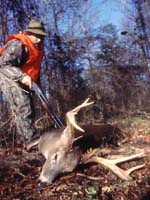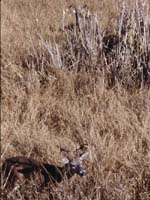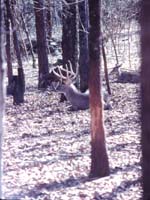
|
Features
|
|
|
|
Books
|
|
|
|
Fun & Games
|
|
|
|
Contact Us
|
|
|
John's Journal... Entry 65, Day 1
Types of Whitetail Highways
 EDITOR'S
NOTE: Simply finding a deer trail won't provide enough information
to make you hang a tree stand and plan to hunt that trail. Many ingredients
make some deer trails better than others. To effectively hunt trails,
you need to know ..
EDITOR'S
NOTE: Simply finding a deer trail won't provide enough information
to make you hang a tree stand and plan to hunt that trail. Many ingredients
make some deer trails better than others. To effectively hunt trails,
you need to know ..
* why and when the deer use the trail,
* where the deer will go and
* what time of day or night the deer will move down the trail.
With this information, you can hunt trails and take deer more productively than a hunter who simply finds a trail and hangs a tree stand. Let's take a closer look at some different types of deer trails and what you can learn from these trails to help you hunt more effectively. Deer use several different kinds of paths or trails -- both obvious and inconspicuous. If you know what to look for and where to look, you can take a stand and drastically increase your ability to find and bag deer.
 Some
hunters detect the movement of deer on all types of trails with fishing
line. They'll string 1- or 2-pound-monofilament fishing line high enough
across a trail that a raccoon or dog normally won't trip it, but a deer
will. Then later, whether that line is broken or not, these hunters will
take that line out of the woods with them when they leave because monofilament
stays in the environment for some time.
Some
hunters detect the movement of deer on all types of trails with fishing
line. They'll string 1- or 2-pound-monofilament fishing line high enough
across a trail that a raccoon or dog normally won't trip it, but a deer
will. Then later, whether that line is broken or not, these hunters will
take that line out of the woods with them when they leave because monofilament
stays in the environment for some time.
Many deer hunters have found some trails in the woods like horse trails, hiking trails, snowmobile trails, etc. the least productive to hunt -- even though they may have numbers of deer tracks on them. Probably the deer are utilizing these trails only at night.
You can locate and read some deer trails easily. Most hunters hunt and spook deer on these public-land trails. Deer often use these trails at night, leaving plenty of sign, but never travel them during daylight hours. However, you'll usually find the most deer on invisible trails, the kind of trails that only veteran woodsman will pinpoint.
"Deer have historical trails that they use for generations to travel from one woodlot to another," Larry Norton of Pennington, Alabama, a guide at Bent Creek Hunting Lodge near Jachin, Alabama, and a member of the Mossy Oak Hunt Team, said. "Even when deer encounter a clearcut, they still will use these same trails. But as the young pines grow to 4- or 5-feet tall, the trails seem to vanish. However, mark these trails so that you can find them as the pines continue to grow. The deer will never stop using the trails."
 Norton
remains very secretive about the invisible trails he finds when he hunts
in a pine plantation. He tries to enter and exit these areas without anyone's
noticing him. He also never tells other hunters where or how he hunts.
Norton
remains very secretive about the invisible trails he finds when he hunts
in a pine plantation. He tries to enter and exit these areas without anyone's
noticing him. He also never tells other hunters where or how he hunts.
"I'll never hunt a historic trail in a pine plantation with a wrong wind," Norton emphasized. "I don't want to spook the deer on these trails. And I don't hunt these trails more than once per week."
Tomorrow: Trash Trails and Meandering Trails
Check back each day this week for more about Reading Whitetails' Travel Routes ...
Day 1 -Types of Whitetail
Highways
Day 2 -Trash Trails and Meandering Trails
Day 3 -Terrain Trails and Mating Trails
Day 4 -Water, Food and Bedding Trails
Day 5 -Escape Trails and Night Trails